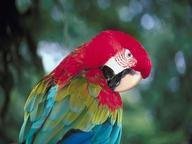Quiz Answer Key and Fun Facts
1. The little budgerigar is native to which continent?
2. What colour is the forehead and face of the natural (wild and free) adult budgerigar?
3. Budgerigars in the wild are much larger than those held and bred in captivity.
4. What part of the bird is the cere?
5. Apart from telling the sex of the bird by its face markings, how else can one distinguish between the sexes?
6. When budgerigars feel threatened, how do they behave?
7. Budgerigars are intelligent little birds, and those kept as pets like to interact with their humans. They can also be taught various tricks and words. Is it true that the male bird has a much larger vocal ability than the female?
8. Budgerigars kept in captivity can cause a specific lung illness in some humans. What is this illness called?
9. When the female budgerigar begins laying, she will lay between four to eight eggs. What is unusual about her laying method?
10. After the baby budgerigars are born, what part, if any, does the father take in their rearing?
Source: Author
Creedy
This quiz was reviewed by FunTrivia editor
crisw before going online.
Any errors found in FunTrivia content are routinely corrected through our feedback system.


